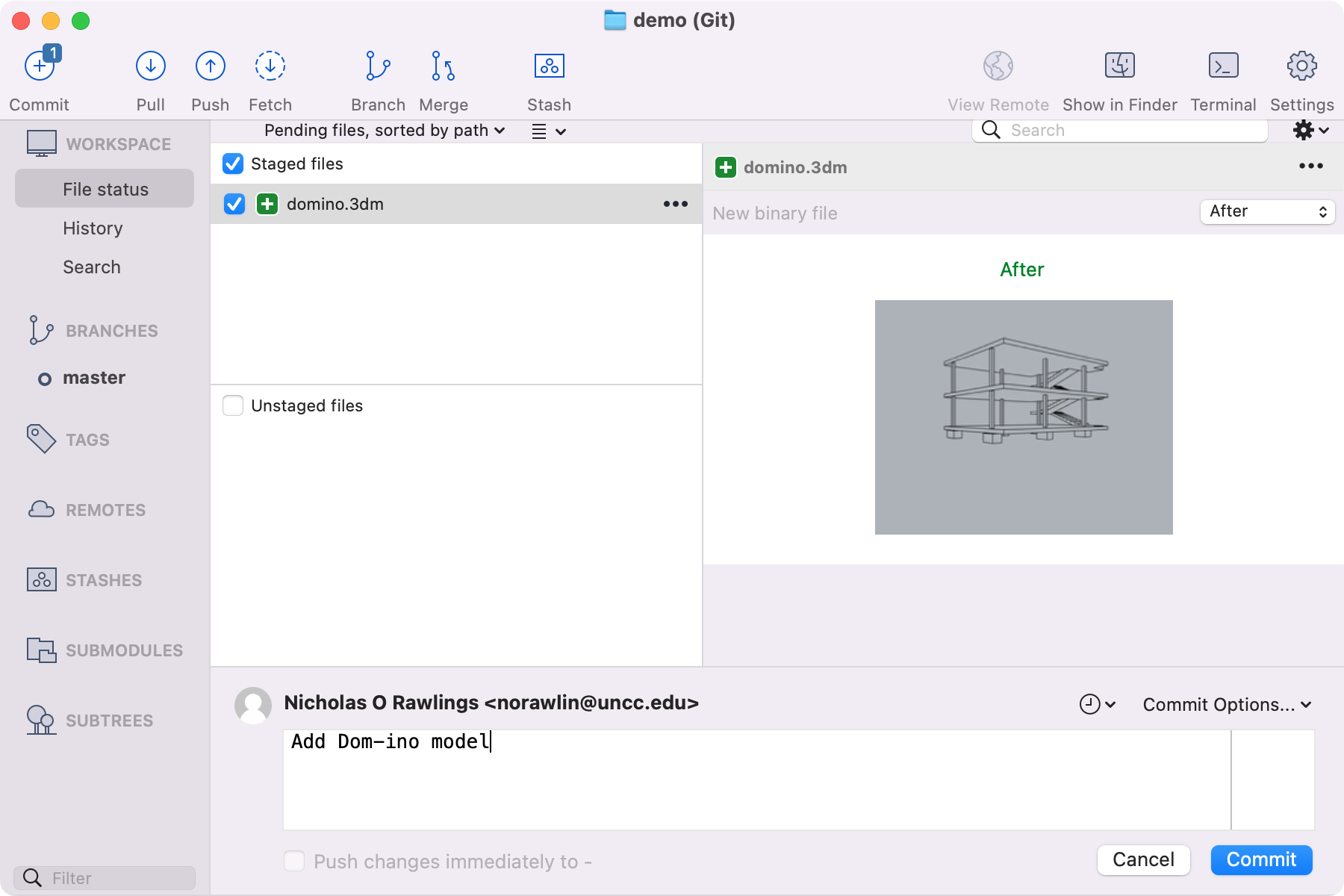5.1 Diffing and Patching
The operation of the 3dmdiff, 3dmpatch, and 3dmdiff3 programs, along with their ability to work within the context of a Git repository, was demonstrated during the defense of this thesis on December 8, 2022. This demonstration began with an openNURBS model containing the tracing of Le Corbusier's Maison Dom-ino that was used to produce several illustrations in Chapter 2 (Figure 5.1). A copy of that file was created and subsequently modified so that two of the columns on the upper level were joined together to form a wall (Figure 5.2). The 3dmdiff utility was then used to reveal the differences between the two files with the command
which produced the following output:
--- domino.3dm 2022-12-08 11:29:15.385805 -0500
+++ domino_copy.3dm 2022-12-08 11:40:49.943148 -0500
@@ ~LineCurve 18ff88dd-01a4-47ff-96d6-0eaf02ef9484 @@
Domain: [8.272019639391859, 8.606367521859378] -> [-2.6645352591003757e-15, 8.606367521859378]
Geometry: transform(25.74075698852539, 0.0, 0.0, -229.1952667236328, 0.0, 25.74075698852539, 0.0, -632.5133056640625, 0.0, 0.0, 25.74075698852539, 0.0, 0.0, 0.0, 0.0, 1.0)
StartPoint: (17.320573165521864, 28.592050881888326, 0.0) -> (17.32057316552188, 28.59205088188827, 0.0)
EndPoint: (9.263874233629338, 25.565639766035588, 0.0) -> (9.26387423362934, 25.56563976603544, 0.0)
@@ -LineCurve 5ebba82c-b909-4313-8247-6fdc5c634031 @@
Domain: [2.2551487856584056, 9.17534041976403]
StartPoint: (9.966767623614944, 24.781772236940483, 0.0)
EndPoint: (16.828909351701345, 23.887309741135965, 0.0)
@@ -LineCurve b07d85f3-efc1-4c07-be07-06211237b92e @@
Domain: [0.0, 0.39375629476038715]
StartPoint: (9.576868097848447, 25.68321249872336, 0.0)
EndPoint: (9.966767623614944, 25.628236326880554, 0.0)
@@ -LineCurve c4427803-1bc0-4067-9240-464e2f3525b7 @@
Domain: [2.7712785312946515, 10.277364432022416]
StartPoint: (16.82890935170135, 28.407362730576203, 0.0)
EndPoint: (16.82890935170135, 20.90127682984844, 0.0)
@@ -LineCurve 3b960de7-8cd5-4e90-a263-2be74deb736e @@
Domain: [0.0, 5.920871468485612]
StartPoint: (9.966767623614944, 25.628236326880554, 0.0)
EndPoint: (9.966767623614944, 19.707364858394943, 0.0)
@@ -LineCurve 3c8bf58c-820a-4989-854a-656862c9f028 @@
Domain: [4.7333498517256665, 10.777034288483303]
StartPoint: (9.576868097848447, 25.68321249872336, 0.0)
EndPoint: (9.576868097848447, 19.639528061965724, 0.0)
@@ -LineCurve 6d03ffd7-30e4-437d-9003-a608867ba401 @@
Domain: [0.0, 0.5252075961518584]
StartPoint: (17.32057316552188, 28.59205088188826, 0.0)
EndPoint: (16.82890935170135, 28.407362730576203, 0.0)
The hunk beginning on the third line of the output describes the line that was extended to form the top of the wall. Its transformation matrix indicates that the line in Figure 5.2 is roughly 25.74 times longer than its counterpart in Figure 5.1. The StartPoint and EndPoint properties on lines 6 and 7 were not expected to be included in the delta since the transformation matrix fully describes the changes that were made to the line's geometry. Their appearance is due to floating-point rounding errors, which will be discussed in Section 6.2.
The other hunks in the delta correspond to lines that were removed from the model. Their domains and start and end points are listed in the delta so that the lines can be recreated in the event of a reverse patch.
The demonstration continued by re-running the 3dmdiff command, this time saving the output to a file:
Next, the modified copy of the Dom-ino tracing was deleted. It was then re-created by applying the saved delta to the original file using 3dmpatch:
It would also have been possible to delete and re-create the original file using a reverse patch:
3dmpatch -R -o domino_revpatched.3dm domino_copy.3dm domino_deltaHowever, this functionality was not demonstrated during the defense.








